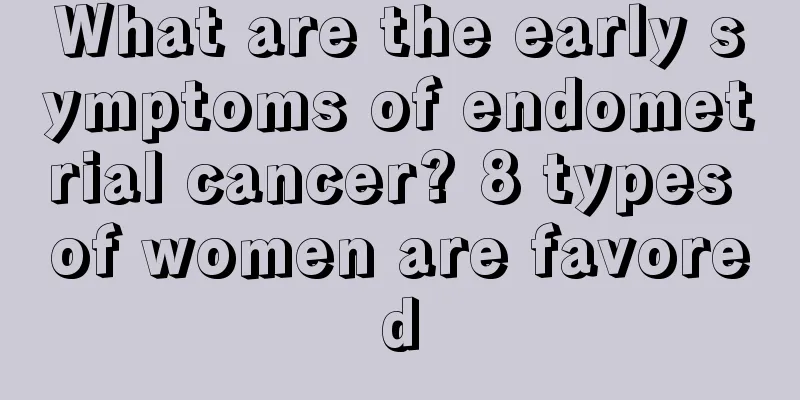What are the early symptoms of endometrial cancer? 8 types of women are favored

|
What is endometrial cancer? Endometrial cancer, also known as uterine body cancer, is a common gynecological malignancy, second only to cervical cancer in incidence. It can be divided into glandular keratinizing carcinoma, adenocarcinoma, clear cell carcinoma, and squamous cell carcinoma. Endometrial cancer poses a serious health threat to women today, so what exactly is endometrial cancer? What are the early symptoms of endometrial cancer? Endometrial cancer, also known as uterine body cancer, is a malignant tumor that occurs in the endometrium. Its incidence is slightly lower than that of cervical cancer, ranking second among gynecological malignancies. This disease mostly occurs in women over 50 years old, especially those aged 55 to 60. In order to detect and treat endometrial cancer early, it is necessary to understand some of the early signs of this disease. 1. Increased vaginal discharge: Increased vaginal discharge is another symptom of endometrial cancer, and sometimes it is the first symptom. It starts out as watery, then becomes purulent or bloody. 2. Abdominal pain: In the early stage, patients generally do not have abdominal pain, but some patients may feel soreness and discomfort in the lower abdomen. In the late stage, the tumor invades the pelvic cavity and compresses the nerves, which can cause obvious abdominal pain. When there is secondary infection and pus accumulation in the uterine cavity, there will be spasmodic abdominal pain. 3. Postmenopausal vaginal bleeding: Postmenopausal bleeding or irregular vaginal bleeding is a prominent and typical symptom of endometrial cancer patients, which can appear in the early stage. The initial bleeding is small and intermittent, with less bleeding than the previous menstrual volume, sometimes even less, with only a small amount of blood on the underwear, and the intervals vary from a few days to a few weeks. Occasionally, the intervals between bleeding can be longer. In the late stage of the disease, the amount of bleeding can be a lot, exceeding the previous menstrual volume and is continuous, sometimes even causing anemia. Premenopausal women may experience intermenstrual bleeding, prolonged menstrual bleeding, increased menstrual volume or completely irregular bleeding. Endometrial cancer is "favored" by these eight types of women 1. Infertility The high risk factor of endometrial cancer decreases with the increase of the number of births. Women with infertility caused by long-term anovulation are more likely to suffer from this disease than women who have given birth to one child. Patients with polycystic ovary syndrome are also prone to this disease for the same reason. 2. People who take exogenous estrogen for a long time for various reasons The use of exogenous estrogen alone without progestin antagonism may increase the risk of endometrial cancer, which is related to the dose and duration of estrogen use. If progestin is added to antagonize, the risk can be reduced. 3. People with menstrual disorders, early menarche or delayed menopause In the period before menopause, the woman is often in an anovulatory state, and the endometrium undergoes proliferative changes after being stimulated for a long time by a single estrogen without progesterone opposition. 4. Diabetes and hypertension Some patients with diabetes, hypertension, etc. may develop polycystic ovary syndrome, atypical endometrial hyperplasia, and excessive estrogen levels in the body due to long-term pituitary abnormalities, which is also a cause of cancer. 5. Obese people Obesity is a manifestation of endocrine imbalance. A large amount of fat in the body increases the storage of estrogen. Fat also promotes the catabolic action of androgens, increases the estrogen content in the blood, and leads to endometrial hyperplasia and even cancer. 6. Patients with uterine bleeding that has not been cured for a long time Especially after menopause, uterine bleeding should be considered as a possibility of endometrial cancer, and a gynecological examination should be conducted as soon as possible to facilitate early detection and treatment. 7. People with high income and higher education Compared with the poorer people, the risk of endometrial cancer is twice as high, which may be related to excessive fat intake and less physical activity. 8. Those with a history of X-ray exposure Due to the influence of genetic factors, patients with endometrial cancer often have a family history or a history of cancer in close relatives. Therefore, those with a family history of endometrial cancer and a history of cancer in close relatives have an increased risk of the disease. |
<<: What are the most common health care measures for uterine cancer in daily life?
Recommend
Vertical stripes on fingernails_Vertical stripes on fingernails
If a person's fingernails are well-growth, it...
Is it good to do atomization frequently?
In life, when many people see a doctor for illnes...
I have a strong aunt feeling and I am pregnant_I have a strong aunt feeling and I am pregnant
Some female friends will experience various sympt...
Tips for floor scratches
When Chinese people decorate their houses, they u...
How to strengthen prostate cancer prevention through diet
The prostate is a male-specific organ. Almost all...
How to effectively prevent bile duct cancer
Biliary duct cancer is even more dangerous than p...
What should I pay attention to after getting my eyeliner done
The eyes don't have to be big, but they must ...
How can we detect bladder cancer in the early stage? Pay attention to these causes of bladder cancer
When it comes to bladder cancer, many people may ...
What is the most effective way to treat physical weakness and excessive sweating?
Physical weakness and excessive sweating is a com...
Where is the best place to get TCM treatment for cervical cancer
Where is the best place to see TCM for treating c...
How to remove lip scars
Scars are a problem for most people. They leave a...
The correct way to eat yew
Among many precious tree species, yew is one of t...
How to treat claustrophobia?
People with claustrophobia usually experience anx...
What causes buttock pain?
Many friends feel pain in their skin and bones af...
What are the methods to clear stomach fire and get rid of bad breath
If the body has excessive stomach fire, it will b...









